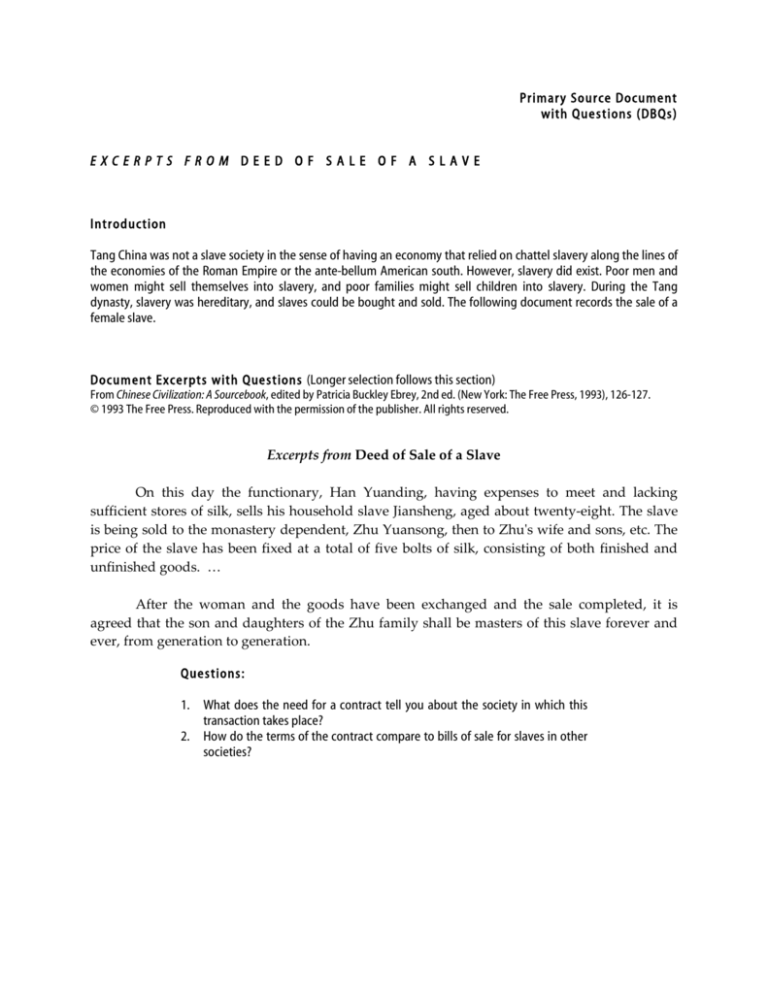
Primary Source Document
with Questions (DBQs)
EXCERPTS FROM DEED OF SALE OF A SLAVE
Introduction
Tang China was not a slave society in the sense of having an economy that relied on chattel slavery along the lines of
the economies of the Roman Empire or the ante-bellum American south. However, slavery did exist. Poor men and
women might sell themselves into slavery, and poor families might sell children into slavery. During the Tang
dynasty, slavery was hereditary, and slaves could be bought and sold. The following document records the sale of a
female slave.
Document Excerpts with Questions (Longer selection follows this section)
From Chinese Civilization: A Sourcebook, edited by Patricia Buckley Ebrey, 2nd ed. (New York: The Free Press, 1993), 126-127.
© 1993 The Free Press. Reproduced with the permission of the publisher. All rights reserved.
Excerpts
from
Deed
of
Sale
of
a
Slave
On
this
day
the
functionary,
Han
Yuanding,
having
expenses
to
meet
and
lacking
sufficient
stores
of
silk,
sells
his
household
slave
Jiansheng,
aged
about
twenty‑eight.
The
slave
is
being
sold
to
the
monastery
dependent,
Zhu
Yuansong,
then
to
Zhuʹs
wife
and
sons,
etc.
The
price
of
the
slave
has
been
fixed
at
a
total
of
five
bolts
of
silk,
consisting
of
both
finished
and
unfinished
goods.
…
After
the
woman
and
the
goods
have
been
exchanged
and
the
sale
completed,
it
is
agreed
that
the
son
and
daughters
of
the
Zhu
family
shall
be
masters
of
this
slave
forever
and
ever,
from
generation
to
generation.
Questions:
1. What does the need for a contract tell you about the society in which this
transaction takes place?
2. How do the terms of the contract compare to bills of sale for slaves in other
societies?
Primary Source Document with Questions (DBQs) on
EXCERPTS FROM DEED OF SALE OF A SLAVE
Longer Selection
From Chinese Civilization: A Sourcebook, edited by Patricia Buckley Ebrey, 2nd ed. (New York: The Free Press, 1993), 126-127.
© 1993 The Free Press. Reproduced with the permission of the publisher. All rights reserved.
Excerpts
from
Deed
of
Sale
of
a
Slave
A
contract
executed
on
the
12th
day
of
the
eleventh
month
of
991.
On
this
day
the
functionary,
Han
Yuanding,
having
expenses
to
meet
and
lacking
sufficient
stores
of
silk,
sells
his
household
slave
Jiansheng,
aged
about
twenty‑eight.
The
slave
is
being
sold
to
the
monastery
dependent,
Zhu
Yuansong,
then
to
Zhuʹs
wife
and
sons,
etc.
The
price
of
the
slave
has
been
fixed
at
a
total
of
five
bolts
of
silk,
consisting
of
both
finished
and
unfinished
goods.1
This
day
the
buyer
has
remitted
three
bolts
of
unfinished
silk.
The
fifth
month
of
next
year
has
been
established
as
the
deadline
for
the
delivery
of
the
remaining
two
bolts
of
finished
silk.
After
the
woman
and
the
goods
have
been
exchanged
and
the
sale
completed,
it
is
agreed
that
the
sons
and
daughters
of
the
Zhu
family
shall
be
masters
of
this
slave
forever
and
ever,
from
generation
to
generation.
If
in
future
a
relative
of
the
seller
should
reclaim
this
slave,
it
is
ordered
that
Han
Yuanding
and
his
wife,
Seventh
Daughter,
seek
out
an
adequate
slave
as
a
replacement.
If
an
imperial
amnesty
should
be
declared
subsequent
to
the
sale,
it
may
not
be
used
to
reopen
discussions
among
the
negotiants.
The
two
parties
to
the
contract
have
met
face
to
face
and
have
reached
their
agreement
after
joint
discussions.
If
one
of
the
parties
should
default,
he
shall
be
fined
one
bolt
of
decorated
silk
and
two
large
rams
—
all
to
be
turned
over
to
the
non‑defaulting
party.
In
light
of
the
chance
of
this
contractʹs
not
being
made
in
good
faith,
the
following
persons
have
witnessed
it
and
will
serve
as
its
guarantors:
(Note:
In
case
this
woman
should
prove
to
have
a
sickness,
a
waiting
period
of
ten
days
has
been
agreed
upon.
Beyond
this
time
withdrawal
from
the
agreement
will
be
impossible.)
The
woman
whose
person
is
being
sold,
Jiansheng
The
seller
of
the
woman,
her
mistress,
Seventh
Daughter
The
Seller
of
the
woman,
her
master,
Han
Yuanding
A
relative
by
marriage,
who
has
participated
in
the
discussion,
Fuzhen
A
witness,
Monk
Chouda
of
Baoen
Monastery
A
witness,
Monk
Luo
Xian
of
Longxing
Monastery
1
Bolts
of
plain
silk
of
standard
size
and
quality
were
used
as
a
unit
of
currency
for
larger
transactions
in
the
Tang
and
even
formed
a
part
of
the
standard
tax
payment.
Asia for Educators l Columbia University l http://afe.easia.columbia.edu
Page 2 of 3
Primary Source Document with Questions (DBQs) on
EXCERPTS FROM DEED OF SALE OF A SLAVE
(Additional
note:
In
place
of
one
of
the
bolts
of
finished
silk
it
has
been
decided
to
furnish
six
lengths
of
Zhu
serge
and
six
lengths
of
white
serge,
making
a
total
of
twelve
lengths,
each
measuring
between
ten
and
twenty
feet.
These
goods
are
to
be
delivered
by
the
fifth
month
of
next
year.)
[Translated
by
Patricia
Ebrey
and
Clara
Yu]
Asia for Educators l Columbia University l http://afe.easia.columbia.edu
Page 3 of 3








